
The Mark 7 was a remanufactured 14"/50 (35.6 cm) Mark 4 with a smaller chamber, a shell centering cone, a single-slope band seat, uniform rifling and a tube locking ring. The Mark 11 was the Mark 7 with the addition of chromium plating to the bore. During the battleship refits of the 1930s, the New Mexico class and USS California (BB-44) were rearmed with Mark 11 guns, although the battleship USS Tennessee (BB-43) did not receive the updated guns until 1942.
The problems with dispersion experienced with the 14"/50 (35.6 cm) Mark 4 guns seem to have been corrected with these rebuilt weapons. The Mark 7 reduced the chamber length in order to minimize the air gap between the powder bags and the base of the shell and this alone reduced 12-gun pattern size down to less than 700 yards (640 m). At Surigao Strait, USS Tennessee (BB-43) and USS California (BB-44) reported pattern sizes of 300 to 400 yards (275 to 365 m) for six and nine gun salvos at 20,000 yards (18,300 m), which was not appreciably different than that achieved by the newer battleships during the war.
While bombarding Makin Island on 20 November 1943, USS Mississippi (BB-41) suffered an explosion in Turret II which killed 43 men.
The 14"/50 (35.6 cm) Mark B was the original gun intended for the North Carolina (BB-55) class battleships. This weapon was the most powerful 14" (35.6 cm) gun ever designed by the United States and it was considerably simpler and lighter than the older 14"/50 (35.6 cm) guns. The prototype of this weapon was never completed as its development was abandoned when the 14" (35.6 cm) treaty limit was rescinded in 1937, allowing these new battleships to be armed with 16"/45 (40.6 cm) guns. For this reason, the 14" (35.6 cm) Mark B design was never assigned a standard numerical Mark designation.
Nomenclature note: The 14" (35.6 cm) Mark A was the ballistic prototype of all 14" (35.6 cm) guns. This prototype was developed around 1910 from a 13" (33 cm) Mark 2 bored out and relined for the larger projectiles. The finished gun was 33 calibers long. The 14" (35.6 cm) Mark C was a Mark 4 Mod 8 reworked as a prototype for the Mark 11.
The data that follows is specifically for the 14"/50 (35.6 cm) Mark 11 Mod 5 unless otherwise noted.
| Designation | 14"/50 (35.6 cm) Mark 7, Mark 11 and Mark B |
|---|---|
| Ship Class Used On | Marks 7 and 11: New Mexico (BB-40) and Tennessee (BB-43) classes
Mark B: North Carolina (BB-55) (as originally designed) |
| Date Of Design | Mark 7: About 1930
Mark 11: About 1935 Mark B: About 1937 |
| Date In Service | Mark 7: About 1935
Mark 11: About 1940 Mark B: N/A |
| Gun Weight | 179,614 lbs. (81,473 kg) (including breech)
177,440 lbs. (80,487 kg) (without breech) |
| Gun Length oa | 714.0 in (18.136 m) (overall) |
| Bore Length | 700 in (17.780 m) |
| Rifling Length | 607.4 in (15.427 m) |
| Grooves | 92 |
| Lands | N/A |
| Twist | Uniform RH 1 in 25 |
| Chamber Volume | 16,982 in3 (278.3 dm3) |
| Rate Of Fire | Mark 7 and Mark 11: About 1.75 rounds per minute
Mark B: 2 rounds per minute |
The following is primarily adapted from "US Battleships: An Illustrated History" by Norman Friedman:
On 10 October 1942, USS Idaho (BB-42) was the subject of an unusual test to determine the ability of the older battleships to maintain a rate of fire over a prolonged period. During this test, she fired 100 rounds from each of her six forward guns in 156 salvos. Most of these were fired at a range of 21,000 yards (19,200 m), but the range varied from 19,000 to 28,000 yards (17,370 to 25,600 m) and some salvos were air spotted. The sea state was calm and she maintained a speed of about 15 knots during the test. The test was observed by no less than eight BuShips and four BuOrd observers along with the CinCPAC gunnery officer and eight Army officers from the Western Defense Command. The Navy also used this opportunity to train thirty-five battleship officers in spotting techniques, which probably slowed down the firing cycles.The New Mexico class (BB-40), of which USS Idaho was a member, carried 300 projectiles per turret with 67 of these on the turntable, 185 on the fixed structure of the shell deck, 30 in the lower handling room and 18 in the lower shell circle in the fixed stool structure immediately below the turret shell deck. After the turrets were modified in the 1930s to increase their maximum elevation, these latter shells were difficult to access as they had to be first lowered into the lower handling room before they could be hoisted to the gunroom. This modification also hampered the propellant supply, with bags being passed by hand into the lower handling room and then taken by hand to the upper handling room where they were transferred into upper hoists discharging into transfer rooms and the loading level, where four bags were sent from each of two hoists to the wing guns and two bags from each hoist to the center gun.
This complex system worked well during the test, even though ammunition supply depended largely upon muscle power. Only five times before the 148th salvo did any gun fail to fire because it lacked powder and only once because a projectile was not available. BuShips commented that "for a good portion of the time, shell and powder handling lines were crossing each other in the lower powder handling room without causing any confusion. In fact, the flexibility of the powder handling system was most impressive, especially with the relatively green crew manning these stations. . . . 2,400 bags of powder were handled without any breakage. Considerable strength and dexterity were exhibited by shell handlers as they 'walked' the projectiles to any desired location by rocking and turning the shells so their points moved in a horizontal circle of about 6 inch diameter. This indicates the importance of acquired skills in any ammunition handling problem."
During the 156 salvos fired for the test, only for twenty salvos did all six guns fire together. Forty-seven salvos had five guns. There were twenty-two four gun salvos, thirty-one three gun salvos, twenty-five two gun salvos and eleven 1 gun salvos. The average interval between salvos was 1 minute and 24 seconds. One five gun salvo was fired forty-nine seconds after the last one. Salvos sixty to eighty, which were primarily of five guns, were fired at an average interval of sixty-seven seconds. By the end of the exercise, with both projectiles and propellant having to be transferred from the farthest corners of the shell and powder rooms, salvo firing was delayed and the average interval for salvos 148 to 156 was two minutes. These last salvos were almost all of one gun.
Besides the problems of these last salvos with slow supply of ammunition, ammunition supply was considered satisfactory, with only five salvos prior to 148 having any gun failing to fire due to lack of propellant and only one salvo having a gun failing to fire due to lack of projectile. "Guns generally failed to fire for minor reasons: the need to adjust or replace a gas check pad (seventy-eight times); the need to adjust a rammer (seventy-five times); or a misfire (thirteen times)."
Based upon this test, BuShips concluded that the magazine arrangements of the old battleships were satisfactory, although it had reservations about the performance of the system in heavy weather.
Shortly after this exercise, Idaho entered Puget Sound Navy Yard to be regunned.
| Type | Bag |
|---|---|
| Projectile Types and Weights | AP Mark 16 Mods 1 to 11 - 1,500 lbs. (680.4 kg)
HC Mark 19 Mods 2 to 6 - 1,275 lbs. (578 kg) 1 HC Mark 22 Mod 0 - 1,275 lbs. (578 kg) 1 Target Mark 17 - 1,500 lbs. (680.4 kg) 2 Target Mark 18 - 1,500 lbs. (680.4 kg) |
| Bursting Charge | AP Mark 16 - 22.90 lbs. (10.4 kg) Explosive D
HC Mark 19 - 104.21 lbs. (47.3 kg) Explosive D HC Mark 22 - 104.21 lbs. (47.3 kg) Explosive D |
| Projectile Length | Mark 16 AP - 56.00 in (142.2 cm)
HC Mark 19 Mods 2 to 6 - 56.00 in (142.2 cm) HC Mark 22 Mod 0 - 56.00 in (142.2 cm) Target Mark 17 - 56.00 in (142.2 cm) Target Mark 18 - 56.00 in (142.2 cm) |
| Propellant Charge 3 4 | Full Charge - 420 lbs. (190.5 kg) SPD
Reduced Charge - 195 lbs. (88.5 kg) SPDN
|
| Muzzle Velocity | Full Charge - New Gun
AP - 2,700 fps (823 mps) HC - 2,825 fps (861 mps) Reduced Charge - New Gun
|
| Working Pressure | 18.0 tons/in2 (2,835 kg/cm2) |
| Approximate Barrel Life | Mark 7: 175 to 200 rounds
Mark 11: 200 to 250 rounds Mark B: N/A |
| Ammunition stowage per gun | 100 rounds |
- ^1.11.2HC Mark 22 was similar to the HC Mark 19 except that the rotating band was about 1.25 inches (3.2 cm) closer to the base. HC projectile bodies could be used with Point Detonating (PD) or Mechanical Time (MT) fuzes. When used with PD fuzes, they were considered to be HC rounds. When used with MT fuzes, they were considered to be AAC rounds. MT fuzes were probably set by hand on the loading trays.
- ^Target Mark 17 used blind loaded and plugged (BL&P) AP Mark 16 projectile bodies. The Mark 18 was identical to the Mark 17 but used a dye spotting load.
- ^When the chamber size was reduced during the modernization process, the propellant charge weight was cut by 50 lbs. (22.7 kg). This meant that all 14" (35.6 cm) guns now shared the same charge, which had obvious advantages from a logistical point of view. Even with the smaller charge, the 14"/50 (35.6 cm) gun still enjoyed a higher muzzle velocity and longer range over the shorter guns as well as better armor penetration capability. However, reduced charges were smaller than those for the 14"/45 (35.6 cm) guns, in order to obtain the same muzzle velocity.
- ^Propellant was in four bags.
- After 1941 AP rounds had a nominal 1.5 lbs. (0.68 kg) dye bag but this was allowed to be as large as 3.0 lbs. (1.36 kg) in order to bring underweight projectiles up to standard. Battleships were assigned the following dye colors:
New Mexico (BB-40) - Green
Mississippi (BB-41) - Orange
Idaho (BB-42) - Blue
Tennessee (BB-43) - No Dye
California (BB-44) - No Dye - Bourrelet diameter was 13.977 inches (35.5 cm).
| Elevation | Range | Angle of Fall | Time of Flight | Striking Velocity | Maximum Ordinate |
|---|---|---|---|---|---|
| 1.64 degrees | 4,000 yards (3,658 m) | 1.67 degrees | 4.71 seconds | 2,409 fps (734 mps) | 89 ft (27 m) |
| 4.62 degrees | 10,000 yards (9,140 m) | 5.60 degrees | 12.86 seconds | 2,031 fps (619 mps) | 661 ft (201 m) |
| 7.02 degrees | 14,000 yards (12,802 m) | 9.10 degrees | 19.10 seconds | 1,829 fps (557 mps) | 1,460 ft (445 m) |
| 11.31 degrees | 20,000 yards (18,290 m) | 15.73 degrees | 29.59 seconds | 1,611 fps (491 mps) | 3,520 ft (1,072 m) |
| 14.65 degrees | 24,000 yards (21,946 m) | 21.17 degrees | 37.55 seconds | 1,515 fps (462 mps) | 5,690 ft (1,734 m) |
| 21.00 degrees | 30,000 yards (27,430 m) | 31.1 degrees | 51.55 seconds | 1,435 fps (437 mps) | 10,760 ft (3,280 m) |
| 26.35 degrees | 34,000 yards (31,090 m) | 38.33 degrees | 62.61 seconds | 1,429 fps (436 mps) | 15,880 ft (4,840 m) | 29.52 degrees | 36,000 yards (32,918 m) | 42.12 degrees | 68.86 seconds | 1,442 fps (440 mps) | 19,210 ft (5,855 m) | 33.23 degrees | 38,000 yards (34,747 m) | 46.12 degrees | 75.92 seconds | 1,467 fps (447 mps) | 23,340 ft (7,114 m) |
- ^Values for AP Mark 16 from BuOrd OP 1188 page 49.
- ^The maximum turret elevation of the New Mexico and Tennessee classes was 30 degrees. At that elevation, the range for the AP Mark 16 would have been about 36,800 yards (33,650 m).
| Elevation | Range | Angle of Fall | Time of Flight | Striking Velocity | Maximum Ordinate |
|---|---|---|---|---|---|
| 1.69 degrees | 4,000 yards (3,658 m) | 1.58 degrees | 4.48 seconds | 2,541 fps (774 mps) | 80 ft (24 m) |
| 4.39 degrees | 10,000 yards (9,140 m) | 5.05 degrees | 12.24 seconds | 2,131 fps (650 mps) | 600 ft (183 m) |
| 6.60 degrees | 14,000 yards (12,802 m) | 8.38 degrees | 18.28 seconds | 1,885 fps (575 mps) | 1,340 ft (408 m) |
| 10.78 degrees | 20,000 yards (18,290 m) | 15.48 degrees | 29.01 seconds | 1,584 fps (483 mps) | 3,380 ft (1,030 m) |
| 14.24 degrees | 24,000 yards (21,946 m) | 21.73 degrees | 37.35 seconds | 1,446 fps (441 mps) | 5,620 ft (1,713 m) |
| 20.68 degrees | 30,000 yards (27,430 m) | 32.68 degrees | 51.85 seconds | 1,342 fps (409 mps) | 10,840 ft (3,304 m) |
| 25.94 degrees | 34,000 yards (31,090 m) | 40.25 degrees | 63.02 seconds | 1,337 fps (408 mps) | 16,010 ft (488 m) | 28.97 degrees | 36,000 yards (32,918 m) | 43.97 degrees | 69.19 seconds | 1,353 fps (412 mps) | 19,300 ft (5,883 m) | 32.37 degrees | 38,000 yards (34,747 m) | 47.62 degrees | 75.96 seconds | 1,380 fps (421 mps) | 23,240 ft (7,084 m) |
| Range | Side Armor | Deck Armor | Striking Velocity | Angle of Fall |
|---|---|---|---|---|
| 0 yards (0 m) (new gun) | 28.03" (712 mm) | --- | 2,700 fps (823 mps) | 0 |
| 0 yards (0 m) (avg. gun) | 27.17" (690 mm) | --- | 2,625 fps (800 mps) | 0 |
| 5,000 yards (4,572 m) | 23.66" (601 mm) | 0.48" (12 mm) | 2,326 fps (709 mps) | 2.36 |
| 10,000 yards (9,144 m) | 20.12" (511 mm) | 1.27" (32 mm) | 2,040 fps (622 mps) | 5.61 |
| 15,000 yards (13,716 m) | 16.76" (426 mm) | 2.13" (54 mm) | 1,789 fps (545 mps) | 10.23 |
| 20,000 yards (18,288 m) | 13.75" (349 mm) | 3.02" (77 mm) | 1,588 fps (484 mps) | 16.33 |
| 25,000 yards (22,860 m) | 11.27" (286 mm) | 4.05" (103 mm) | 1,455 fps (443 mps) | 24.08 |
| 30,000 yards (27,432 m) | 9.29" (236 mm) | 5.31" (135 mm) | 1,390 fps (424 mps) | 33.0 |
| 35,000 yards (32,004 m) | 7.82" (199 mm) | 6.97" (177 mm) | 1,402 fps (427 mps) | 42.5 |
This data is from "Battleships: United States Battleships 1935-1992" and is based upon the USN Empirical Armor Penetration formula.
| Designation | Three-gun Turrets 1c New Mexico (4) and Tennessee (4) Four-gun Turrets
|
|---|---|
| Weight | Three-gun Turrets
897 - 958 tons (911.35 - 973.21 mt) Four-gun Turrets
|
| Elevation | -5 / +30 degrees 2c |
| Elevation Rate | about 9 degrees per second |
| Train | 306 max 297 min degrees |
| Train Rate | about 2 degrees per second |
| Gun Recoil | 48 in (1.219 m) |
| Loading Angle | New Mexico class: 0 degrees
Tennessee Class: +1 degree |
- ^Unlike earlier USN 14" (35.6 cm) turrets, the guns in these mountings were individually sleeved.
- ^As built, the New Mexico class had a maximum elevation of +15 degrees. This was increased to +30 degrees during reconstruction in the 1930s. Each turret had a crew of 98 men at this time. The Tennessee class had a maximum elevation of +30 degrees as originally built.
- Delay coils were fitted in the early 1930s which delayed the firing of the center gun by about 0.060 seconds (60 milliseconds). These reduced the dispersion pattern by about half.
- See 14"/50 (35.6 cm) Mark 4 data page for other information about these mountings.
- USS Mississippi (AG-128) was converted into a gunnery training ship in 1946, replacing USS Wyoming (AG-17) in this role. As part of the conversion, her main battery turrets No. 1, 2 and 3 were removed, leaving only No. 4 in place. Turret No. 4 was removed in 1952 and replaced with two Terrier (RIM-2) twin launchers.
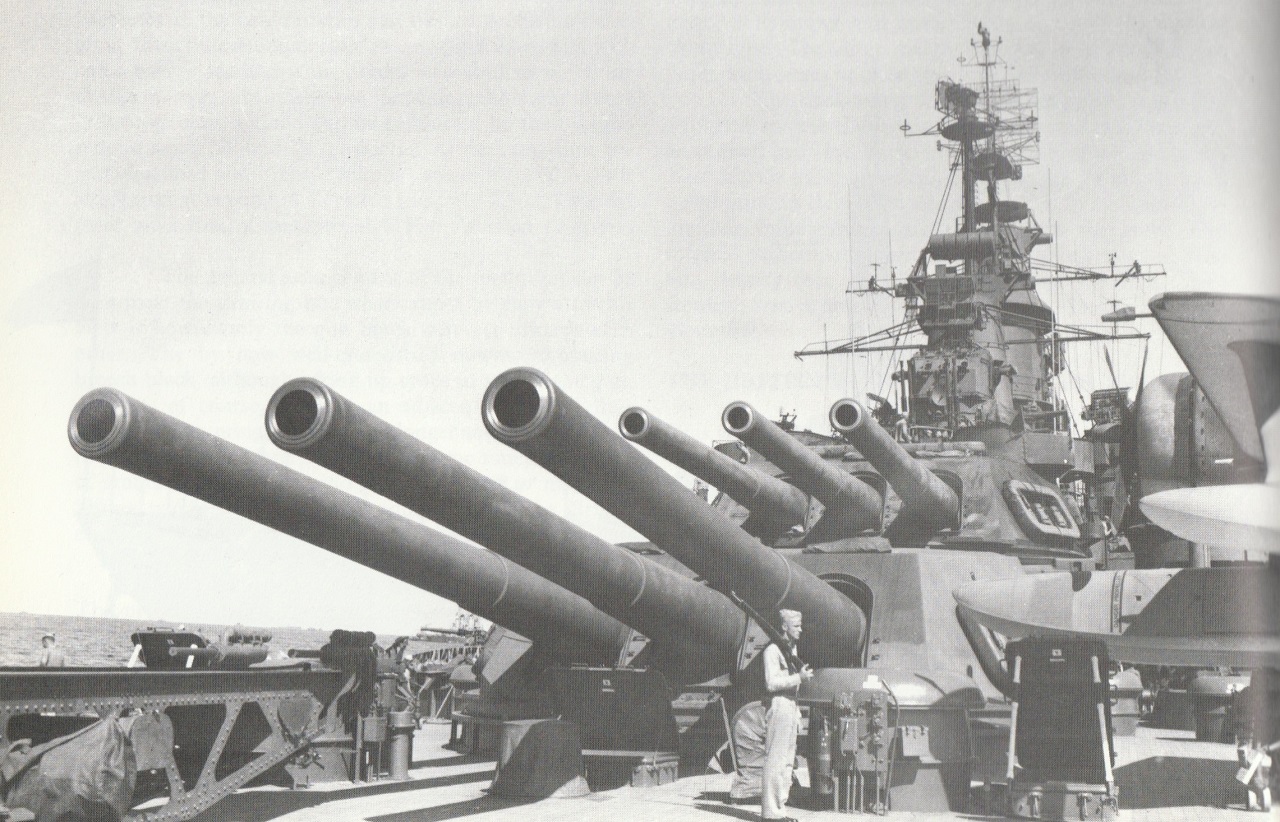
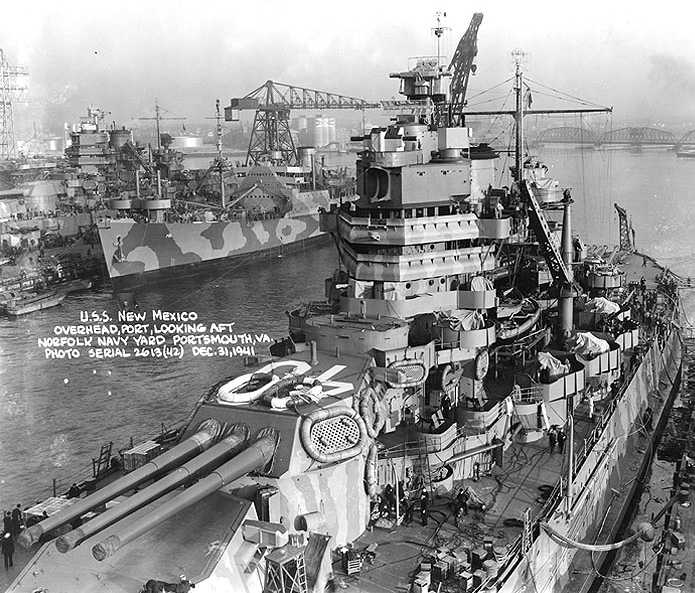
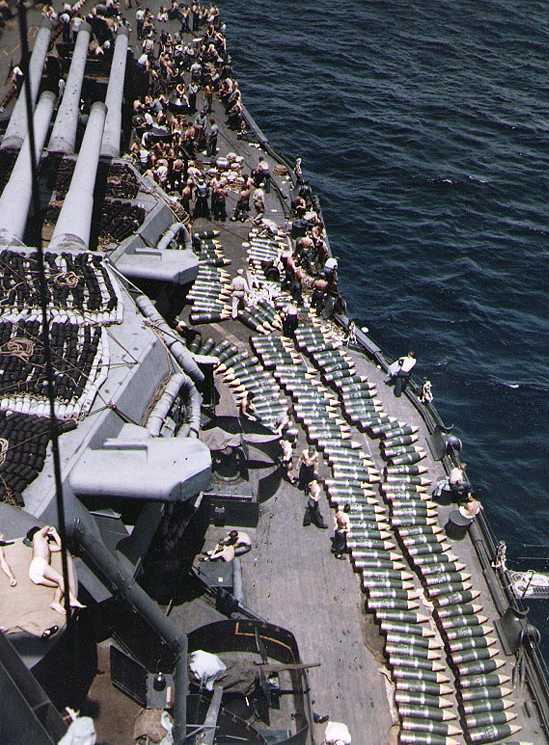
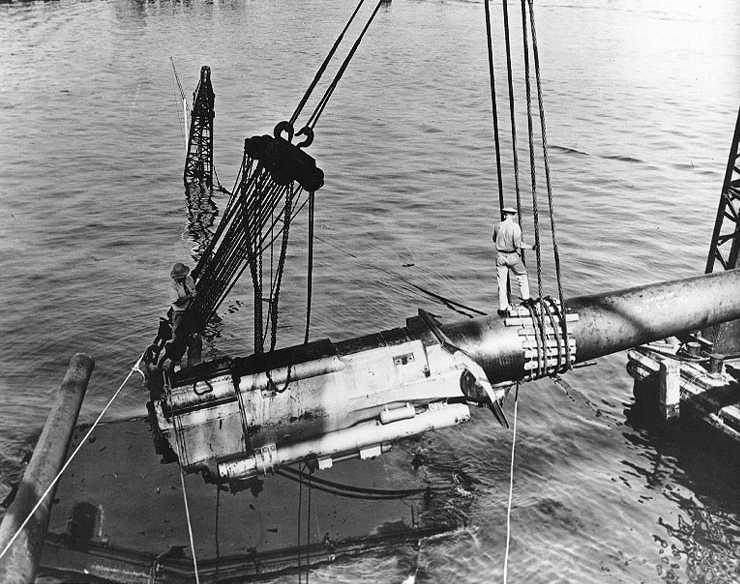

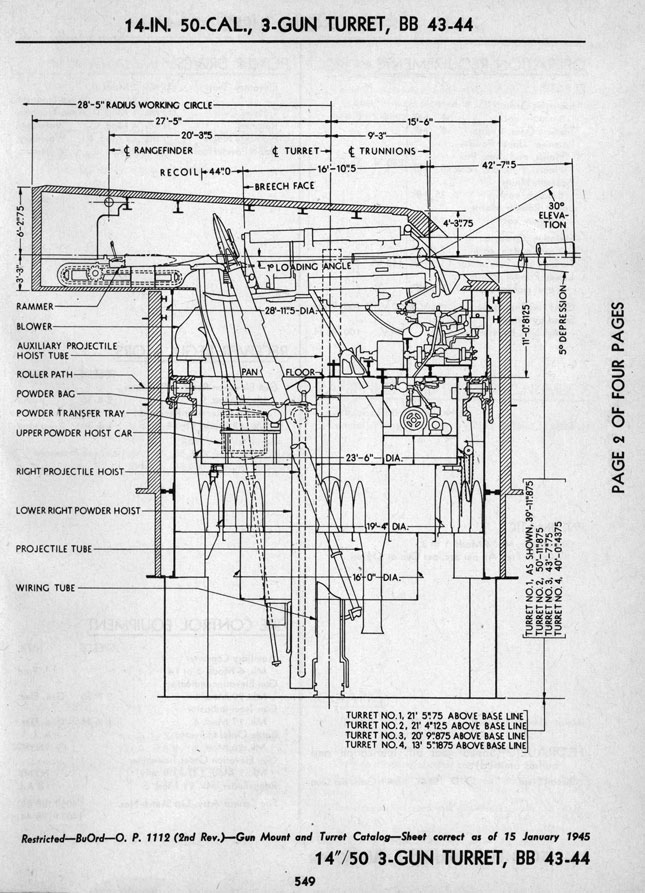
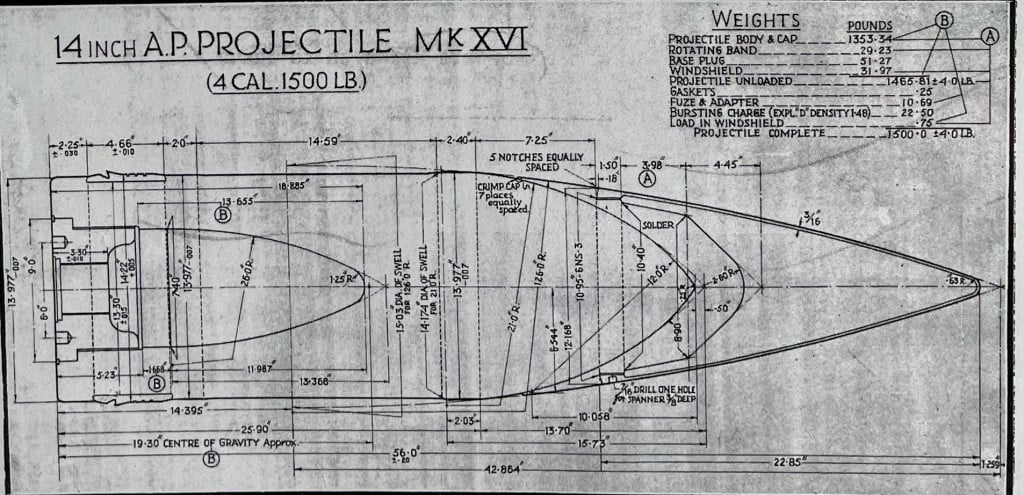
"Naval Weapons of World War Two" by John Campbell
"Naval Weapons of World War One", "US Naval Weapons" and "US Battleships: An Illustrated Design History" all by Norman Friedman
"Battleships: United States Battleships, 1935-1992" by W.H. Garzke, Jr. and R.O. Dulin, Jr.
"The Big Gun: Battleship Main Armament 1860-1945" by Peter Hodges
---
"USS Massachusetts 1945 Gunnery Doctrine" USN BuOrd Publication
USS Tennessee and USS California Action Reports from Surigao Strait Battle
"Abridged Range Tables for U.S. Naval Guns - Ordnance Pamphlet No. 1188 - 13 June 1944" by Bureau of Ordnance (BuOrd), Department of the Navy
"U.S. Explosive Ordnance - Ordnance Pamphlet No. 1664 - 28 May 1947" by Bureau of Ordnance (BuOrd), Department of the Navy
---
Gene Slover's Navy Pages
---
Special help by Ed Jackson
07 February 2008 - Benchmark
31 December 2009 - Added information on Idaho firing test
11 July 2016 - Converted to HTML 5 format
05 November 2016 - Corrected typographical error
20 December 2018 - Added turret sketches, reorganized notes
03 April 2020 - Added information on changes to reduce pattern size
30 April 2022 - Redid photograph of USS California, updated links
03 June 2022 - Added Target projectiles
21 May 2023 - Added note about USS Mississippi (AG-128) as a gunnery training ship
09 August 2023 - Revised range tables
09 September 2023 - Added USS Mississippi accident
07 April 2024 - Added sketch of APC Mark 16
30 July 2024 - Added to the Gun Description section
